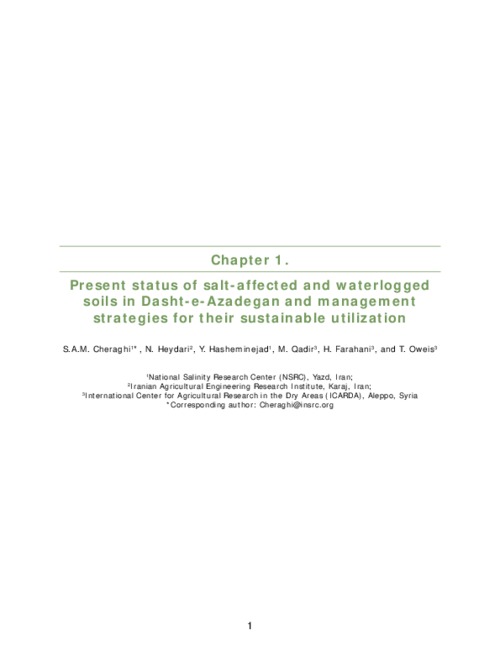Location
The International Center for Agricultural Research in the Dry Areas (ICARDA) was established in 1977. It is one of 15 such centers supported by the CGIAR. ICARDA’s founding mandate to promote agricultural development in the dry areas of developing countries remains highly relevant today.
ICARDA works with a tight focus on the problem-solving needs of resource-poor farmers, achieving this through the in-field delivery of its research outputs. Although global food production has increased by 20 per cent in the past decade, food insecurity and poverty remain widespread, while the natural resource base continues to decline.
International research centers such as ICARDA, which have helped drive previous improvements, continue to deliver new technologies to support sustainable growth in agriculture, and crucially, to work with a wide range of partners to accelerate the dissemination of these technologies.
ICARDA’s biggest strength is its staff – 600 highly skilled men and women from 32 countries. Our research and training activities cover crop improvement, water and land management, integrated crop-livestock-rangeland management, and climate change adaptation.
Other interventions include:
- Water harvesting - supplemental irrigation and water-saving irrigation techniques
- Conservation agriculture methods to reduce production costs and improve sustainability
- Diversification of production systems to high-value crops – horticulture, herbal and medicinal plants
- Integrated crop/rangeland/livestock production systems including non-traditional sources of livestock feed
- Empowerment of rural women – support and training for value-added products.
The ICARDA genebank holds over 135,000 accessions from over 110 countries: traditional varieties, improved germplasm, and a unique set of wild crop relatives. These include wheat, barley, oats and other cereals; food legumes such as faba bean, chickpea, lentil and field pea; forage crops, rangeland plants, and wild relatives of each of these species.
ICARDA’s research portfolio is part of a long-term strategic plan covering 2007 to 2016, focused on improving productivity, incomes and livelihoods among resource-poor households.
The strategy combines continuity with change – addressing current problems while expanding the focus to emerging challenges such as climate change and desertification.
We work closely with national agricultural research systems and government ministries. Over the years the Center has built a network of strong partnerships with national, regional and international institutions, universities, non-governmental organizations and ministries in the developing world and in industrialized countries with advanced research institutes.
THE ‘DRY AREAS’
Research and training activities cover the non-tropical dry areas globally, using West Asia, North Africa, Central Asia and the Caucasus as research platforms to develop, test, and scale-out new innovations and policy options.
Dry areas cover 41 per cent of the world’s land area and are home to one-third of the global population. About 16 per cent of this population lives in chronic poverty, particularly in marginal rainfed areas. The dry areas are challenged by rapid population growth, frequent droughts, high climatic variability, land degradation and desertification, and widespread poverty. The complex of relationships between these challenges has created a "Poverty Trap."
Members:
Resources
Displaying 381 - 385 of 431Microcatchment water harvesting systems for fruit trees and shrubs
This report will focus on results of 2004/05 and 2005/06 seasons in which the conventional handmade microcatchment was compared to the mechanized one through research done at the Jordan University of Science and Technology site.
Mechanization of transplanting shrubs seedlings and contours laser guiding for Vallerani system
In relevance to the project objectives and expected outputs, the reported research aimed at introducing a mechanized transplanting technique to the WH system to reduce costs and time of establishment of fodder shrubs, thus improving overall system capacity and making large-scale implementation more feasible. Therefore, the expected output is to improve WH and re-vegetation techniques with less cost and time of establishment for fodder shrubs.
Adoption and impact of supplemental irrigation in wheat-based systems in Syria
Agriculture in Syria depends on a wide base of varied natural resources extending over five agro-ecological zones differing in total precipitation, soil structure, and water resources such as rivers, springs, dams, and groundwater which supplies water for about 851,000 ha (61% of the total irrigated areas). However, precipitation is considered as the main source of the water needed to establish the widespread rainfed system of agriculture, which occupies 70% of the cultivated area in Syria.
Management practices for improving water productivity in the Dasht-e-Azadegan
Wheat is the main cultivated crop in the LKRB (mainly the Dashte- Azadegan plain). Its average yield is 1500 kg/ha (Agricultural Statistics 2004). Irrigation management practices are traditional and the region suffers from poor water management, which is partly due to lack of modern irrigation infrastructure and improved on-farm activities. Therefore, sound and adoptive solutions are necessary to ameliorate this condition.
Present status of salt-affected and waterlogged soils in Dasht-e-Azadegan and management strategies for their sustainable utilization
Salt-prone land and water resources are major impediments to the optimal utilization of crop production systems in many arid and semi-arid regions of the world, including Iran (Alizadeh et al. 2004; Moghaddam and Koocheki 2004). The salinization of land and water resources has been the consequence of both anthropogenic activities (causing human-induced or secondary salinity and/or sodicity) and naturally occurring phenomena (causing primary fossil salinity and/or sodicity) (Ghassemi et al. 1995).







